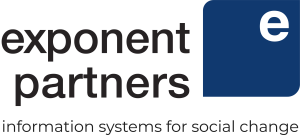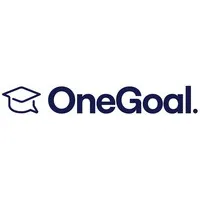Case Study: OneGoal
Highlights
- Improved data-driven decision-making and targeted student support
- Scaled to 250+ program directors using Salesforce to track progress for 6,400+ students
- Increased accuracy of selectivity indices for their focus cities
- Sent/received 54,000+ SMS messages via Salesforce in one year to nudge college enrollment
"We chose Exponent Partners because we wanted to work with people who really understood our work and challenges. We wanted a partner that would be an extension of our team." – Topher Rinek, Senior Director of Data + Systems, OneGoal
Client Description
OneGoal is working to make college graduation a reality for all students. OneGoal collaborates closely with public schools in low-income communities, providing teachers with content, data and support to implement their three year-model with a group of students, called Fellows. Teachers support the same group of Fellows beginning in their junior year of high school and bridge the gap through their first year of college. It’s working: in a nation where only 9% of students from low-income communities graduate from college (Indicators of Higher Education Equity in the United States, Pell Institute 2015 Revised Edition), 82% of OneGoal high school graduates enroll in college and 78% are persisting or have graduated with a college degree.
Introduction
We’ve worked with OneGoal since 2012, and this case study tracks the journey they’ve taken from manual data processes to unifying their information and managing student results.
Challenges
Navigating data accuracy
When the organization started investigating Salesforce, important student data was stored in Google Docs, but these spreadsheets weren’t connected. Without an ability to analyze historical data easily, mistakes were being repeated, rather than corrected. As they scaled and entered increasing amounts of data into Salesforce, including cohort data from organizations like the National Student Clearinghouse, they aimed to collect and refine data that was more challenging to verify, like student college enrollment numbers, financial aid package percentages, and more.
Calculating and honing selectivity ratings efficiently
In 2012, Program Directors at individual schools followed a time-consuming manual process to plot each student’s ACT scores against their GPAs to figure out a student’s selectivity, which is used to determine best-fit and match colleges. As they grew and used Salesforce to auto-calculate these ratings for their first location, Chicago, and later their locations of Houston, New York City, and the state of Massachusetts, they noticed that college acceptances had different trends by region. They would need to adjust their selectivity matrices for each to predict better matches for students.
Inefficient communications
In 2012, OneGoal’s program staff spent too much time on one-off email communications with Program Directors, since they did not have a single place to go to enter information about their students. This inefficiency pulled program staff away from strategic work. Later, as they centralized many of their internal communications, they wanted to tackle and track an external engagement challenge: that of “summer melt,” a common situation where students meaning to enroll over the summer do not do so.
Solution
Originally in 2012, OneGoal worked with Exponent Partners to build the foundation of a custom student data and program management solution on the Salesforce platform. Since then, they have iterated on and continue to scale its system together to meet OneGoal’s aim of having a central database to capture all student data points. Key features have been added over time, including college selectivity rating auto-calculations, “zone” tracking for steps in OneGoal’s program, financial aid tracking, SMS Magic text message tracking, and more.
“Salesforce provides the structure we needed to communicate with our Program Staff and Program Directors in one place, while giving us the flexibility to change as our program model evolves and we need to collect different and new data,” explained Topher Rinek, Director of Data Management at OneGoal. “Salesforce has made it possible for us to grow quickly while increasing our effectiveness.”
Results
Informed decision-making and tailored student experience
As OneGoal grows their data collection and visibility using Salesforce, their decisions have become increasingly refined. They not only collect their own data, but also National Student Clearinghouse data and other cohort data, all of which is stored in Salesforce. This data helps verify their students’ enrollment in college, gives them a clearer picture of the college persistence of their Fellows in graduation numbers, and reveals their Fellows’ overall success at various colleges. They use this information to continually improve student support.
As well, OneGoal has been able to personalize student support more and more. For example, they define seven “zones” for students in the third year of their program, each containing targeted academic, financial and social steps for success. As they moved this tracking into Salesforce for individual students, they were also able to begin to offer even more targeted steps based on the type of school. The percentage of steps each student has completed displays on their records, and statuses display as 1) green: on-track, 2) yellow: within reach, and 3) red: off-track. Teachers and staff can prioritize Fellows to support and which specific actions to take, just by looking at their rosters.
They’ve also started to track and assist their students with applying for financial aid, supporting the growth of these submissions. “Whenever students get accepted to a college, we send them a [third-party] FormAssembly form that helps them fill out their financial aid package, Rinek said. “When they submit that form, it ties them to an application record in Salesforce. It calculates their total amount of financial aid and their out-of-pocket cost or percent. When students are deciding which college to move forward with, we have a good idea in terms of what students might be paying and what their gap might be.” This information helps OneGoal highlight affordable colleges for their Fellows, where alumni of the program have had proven success.
“With all data in a central location, we now have better and more information to support our model,” said Rinek. OneGoal is also able to track and communicate the impact the organization has had, and use this data to better predict current and future outcomes.
Real-time analysis of data
“For every input, there is now an output—in the form of a field, a report or a dashboard—that helps the Program Directors immediately in their classroom,” explained Rinek. “Exponent Partners has created a sustainable way for us to manage our data. Instantly as new GPAs or ACT score comes in, a new selectivity rating is calculated.” As OneGoal expanded from Chicago to Houston, New York, and beyond, they were able to develop more accurate selectivity indexes, which map the trends of test scores and GPAs needed for admission to particular colleges.
Recently, they’ve observed that these indexes have regional variations, and are now able to adjust the indexes continually based on their own student admissions data. Students’ selectivity ratings are auto-calculated dynamically in Salesforce based on their ongoing performance and compared against these more nuanced indexes for their particular regions. This quick overview means that program directors are able to smoothly recommend their students to the right schools. From a student’s perspective, objective reports help them see their progress and success recommendations in real-time.
Streamlined communications and processes
Externally, OneGoal now engages with its students to combat summer melt, sending them weekly reminders and prompts via text message tracked in Salesforce using the third-party app SMS Magic. They can also continue the conversation two-way. In the past year, over 54,000 two-way text messages have been sent or received from Salesforce to ensure that students are on track to enroll and persist in college.
Internally, OneGoal program staff can now provide better support to teachers, and program teams are able to focus on the strategic analysis of data, rather than spending their valuable time manipulating it for reporting purposes. Users have access to dashboards, can track students’ performance against goals—by semester and by year—and can report on this data daily, monthly or annually. They’ve been able to integrate their hiring work, tracking all staff applications through their system. As they have matured in their Salesforce usage, they’ve expanded from under 100 users of the system to over 300 users.

